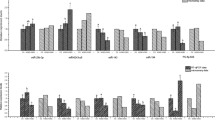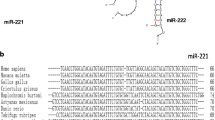Abstract
Micro (mi)RNAs are abundant small noncoding RNAs found in plants and animals, the regulatory functions of which are not fully understood in fish. To identify potential miRNAs, we screened an miRNA microarray with total RNA from zebrafish infected with Vibrio harveyi and another from uninfected zebrafish. Six miRNAs were obtained from the microarray screening. We studied miRNA expression patterns of 2 miRNAs (miR-122 and miR-194) after bacterial infection of transgenic zebrafish (containing tilapia hepcidin (TH)2-3) and non-transgenic zebrafish from which the 2 miRNAs were obtained from the microarray experiment. The results indicated that miR-122 and miR-194 were higher in PBS-injected zebrafish compared with TH2-3 zebrafish or wild-type (WT) zebrafish after V. harveyi infection. Overexpression of miRNAs (miR-122, miR-192, and miR-194a) was seen in zebrafish liver (ZFL) cells after lipopolysaccharide (LPS) treatment and in untreated fish. Our results showed that after 24 h of doxycycline treatment without LPS stimulation, interleukin (IL)-22, lysozyme, toll-like receptor (TLR)1, TLR3, TLR4a, and tumor necrosis factor (TNF)-α gene expressions were, respectively, upregulated by ~14-, 22-, 2.2-, 13-, 200-, and 38-fold in miR-122-transfected compared with non-transfected (WT) ZFL cells. In cells transfected with miR-192 and treated with LPS after 8–12 h, IL-22, lysozyme, TLR1, TLR3, TLR4a, and TNF-α expressions significantly differed between WT and miR-192-overexpressing ZFL cells. However, we observed significantly higher IL-22 expression levels after 12 h of LPS treatment in miR-192-transfected ZFL cells compared with non-transfected cells. In contrast, IL-22, lysozyme, and TNF-α were markedly upregulated (>100-fold) after miR-194a transfection and overexpression in ZFL cells and treatment with LPS. Our cloning and expression analyses indicated that miR-122, miR-192, and miR-194a play important roles in zebrafish immunology.





Similar content being viewed by others
References
Bai S, Nasser MW, Wang B, Hsu SH, Datta J, Kutay H, Yadav A, Nuovo G, Kumar P, Ghoshal K (2009) MicroRNA-122 inhibits tumorigenic properties of hepatocellular carcinoma cells and sensitizes these cells to sorafenib. J Biol Chem 284:32015–32027
Biswas SK, Lopez-Collazo E (2009) Endotoxin tolerance: new mechanisms, molecules and clinical significance. Trends Immunol 30:475–487
Castoldi M, Vujic Spasic M, Altamura S, Elmén J, Lindow M, Kiss J, Stolte J, Sparla R, D’Alessandro LA, Klingmüller U, Fleming RE, Longerich T, Gröne HJ, Benes V, Kauppinen S, Hentze MW, Muckenthaler MU (2011) The liver-specific microRNA miR-122 controls systemic iron homeostasis in mice. J Clin Invest 121:1386–1396
Chiou MJ, Chao TT, Wu JL, Kuo CM, Chen JY (2006) The physiological role of CTGF/CCN2 in zebrafish notochord development and biological analysis of the proximal promoter region. Biochem Biophys Res Commun 349:750–758
Ci X, Ren R, Xu K, Li H, Yu Q, Song Y, Wang D, Li R, Deng X (2010) Schisantherin A exhibits anti-inflammatory properties by down-regulating NF-kappaB and MAPK signaling pathways in lipopolysaccharide-treated RAW 264.7 cells. Inflammation 33:126–136
Cobb BS, Hertweck A, Smith J, O’Connor E, Graf D, Cook T, Smale ST, Sakaguchi S, Livesey FJ, Fisher AG, Merkenschlager M (2006) A role for Dicer in immune regulation. J Exp Med 203:2519–2527
Coulouarn C, Factor VM, Andersen JB, Durkin ME, Thorgeirsson SS (2009) Loss of miR-122 expression in liver cancer correlates with suppression of the hepatic phenotype and gain of metastatic properties. Oncogene 28:3526–3536
Fassi Fehri L, Koch M, Belogolova E, Khalil H, Bolz C, Kalali B, Mollenkopf HJ, Beigier-Bompadre M, Karlas A, Schneider T, Churin Y, Gerhard M, Meyer TF (2010) Helicobacter pylori induces miR-155 in T cells in a cAMP-Foxp3-dependent manner. PLoS One 5:e9500
Fazi F, Rosa A, Fatica A, Gelmetti V, De Marchis ML, Nervi C, Bozzoni I (2005) A minicircuitry comprised of microRNA-223 and transcription factors NFI-A and C/EBPalpha regulates human granulopoiesis. Cell 123:819–831
Giraldez AJ, Cinalli RM, Glasner ME, Enright AJ, Thomson JM, Baskerville S, Hammond SM, Bartel DP, Schier AF (2005) MicroRNAs regulate brain morphogenesis in zebrafish. Science 308:833–838
Hino K, Fukao T, Watanabe M (2007) Regulatory interaction of HNF1-alpha to microRNA-194 gene during intestinal epithelial cell differentiation. Nucleic Acids Symp Ser (Oxf) 51:415–416
Hispano C, Nebra Y, Blanch AR (1997) Isolation of Vibrio harveyi from an ocular lesion in the short sunfish (Mola mola). Bull Eur Assoc Fish Pathol 17:104–107
Hsieh JC, Pan CY, Chen JY (2010) Tilapia hepcidin (TH)2–3 as a transgene in transgenic fish enhances resistance to Vibrio vulnificus infection and causes variations in immune-related genes after infection by different bacterial species. Fish Shellfish Immunol 29:430–439
Johnnidis JB, Harris MH, Wheeler RT, Stehling-Sun S, Lam MH, Kirak O, Brummelkamp TR, Fleming MD, Camargo FD (2008) Regulation of progenitor cell proliferation and granulocyte function by microRNA-223. Nature 451:1125–1129
Jopling CL, Norman KL, Sarnow P (2006) Positive and negative modulation of viral and cellular mRNAs by liver-specific microRNA miR-122. Cold Spring Harb Symp Quant Biol 71:369–376
Kato M, Zhang J, Wang M, Lanting L, Yuan H, Rossi JJ, Natarajan R (2007) MicroRNA-192 in diabetic kidney glomeruli and its function in TGF-beta-induced collagen expression via inhibition of E-box repressors. Proc Natl Acad Sci USA 104:3432–3437
Lau NC, Lim LP, Weinstein EG, Bartel DP (2001) An abundant class of tiny RNAs with probable regulatory roles in Caenorhabditis elegans. Science 294:858–862
Li ZY, Xi Y, Zhu WN, Zeng C, Zhang ZQ, Guo ZC, Hao DL, Liu G, Feng L, Chen HZ, Chen F, Lv X, Liu DP, Liang CC (2011) Positive regulation of hepatic miR-122 expression by HNF4α. J Hepatol 55(3):602–611
Linnstaedt SD, Gottwein E, Skalsky RL, Luftig MA, Cullen BR (2010) Virally induced cellular microRNA miR-155 plays a key role in B-cell immortalization by Epstein-Barr virus. J Virol 84:11670–11678
Meng Z, Fu X, Chen X, Zeng S, Tian Y, Jove R, Xu R, Huang W (2010) miR-194 is a marker of hepatic epithelial cells and suppresses metastasis of liver cancer cells in mice. Hepatology 52:2148–2157
Phelps HA, Neely MN (2005) Evolution of the zebrafish model: from development to immunity and infectious disease. Zebrafish 2:87–103
Sonkoly E, Ståhle M, Pivarcsi A (2008) MicroRNAs and immunity: novel players in the regulation of normal immune function and inflammation. Semin Cancer Biol 18:131–140
Taganov KD, Boldin MP, Chang KJ, Baltimore D (2006) NF-kappaB-dependent induction of microRNA miR-146, an inhibitor targeted to signaling proteins of innate immune responses. Proc Natl Acad Sci USA 103:12481–12486
Toranzo AE, Magarinos B, Romalde JS (2005) A review of the main bacterial fish diseases in mariculture systems. Aquaculture 246:37–61
Vandenberghe J, Li Y, Verdonk L, Li J, Sorgeloos P, Xu HS, Swings J (1998) Vibrios associated with Penaeus chinensis (Crustacae:Decapoda) larvae in Chinese shrimp hatcheries. Aquaculture 169:121–132
Venugopal SK, Jiang J, Kim TH, Li Y, Wang SS, Torok NJ, Wu J, Zern MA (2010) Liver fibrosis causes down-regulation of miRNA-150 and miRNA-194 in hepatic stellate cells and their over-expression causes decreased stellate cell activation. Am J Physiol Gastrointest Liver Physiol 298:G101–G106
Xia JH, He XP, Bai ZY, Yue GH (2011) Identification and characterization of 63 MicroRNAs in the Asian Seabass lates calcarifer. PLoS One 6:e17537
Acknowledgments
This work was supported by a grant from the Development Program of Industrialization for Agricultural Biotechnology to Dr. Cho-Fat Hui under the grant name, “Characterization of microRNAs in fish during normal or disease states.”
Author information
Authors and Affiliations
Corresponding authors
Additional information
Tsung-Han Wu, Chieh-Yu Pan and Ming-Ching Lin contributed equally to this work.
Electronic supplementary material
Below is the link to the electronic supplementary material.
10695_2012_9617_MOESM1_ESM.pdf
Supplementary figure 1. Detection of lipopolysaccharide (LPS)-responsive micro (mi)RNAs. In order to find miRNAs after bacterial infection, microarray spot signal intensities were subjected to a paired t-test analysis. miRNA expression patterns after a Vibrio harveyi (204) infection were compared to those of wild-type (WT-control) zebrafish. Results indicated that 6 miRNAs showed differential expression patterns. Supplementary material 1 (PDF 134 kb)
10695_2012_9617_MOESM2_ESM.pdf
Supplementary figure 2. Expression of micro (mi)RNA in cells from the transient transfection of a zebrafish liver (ZFL) cell line expressing each miRNA. Cells were collected after 24 h and treated with doxycycline (1 mg/ml), and its expression was detected using a qPCR. ZFL represents ZFL cells without transfection of the miRNA plasmid or doxycycline (1 mg/ml) treatment. TFZ + Dox represents ZFL cells transfected with the miRNA plasmid and with doxycycline (1 mg/ml) treatment. TFZ-Dox represents ZFL cells transfected with the miRNA plasmid but without doxycycline (1 mg/ml) treatment. Supplementary material 2 (PDF 136 kb)
Rights and permissions
About this article
Cite this article
Wu, TH., Pan, CY., Lin, MC. et al. In vivo screening of zebrafish microRNA responses to bacterial infection and their possible roles in regulating immune response genes after lipopolysaccharide stimulation. Fish Physiol Biochem 38, 1299–1310 (2012). https://doi.org/10.1007/s10695-012-9617-1
Received:
Accepted:
Published:
Issue Date:
DOI: https://doi.org/10.1007/s10695-012-9617-1




